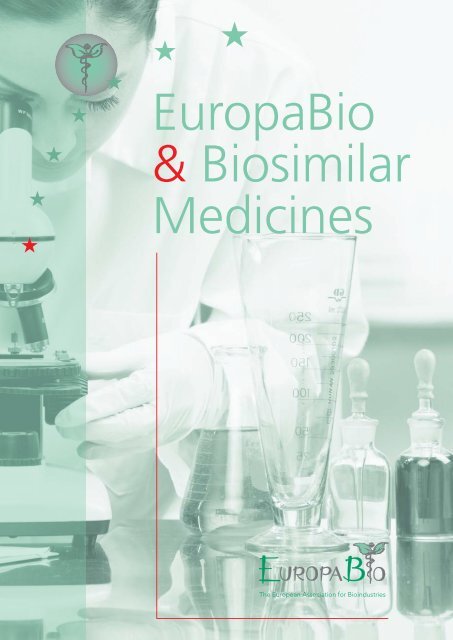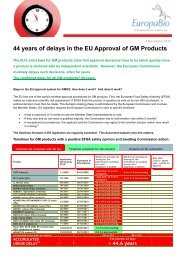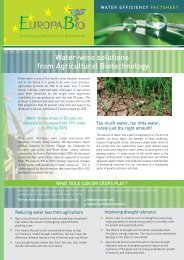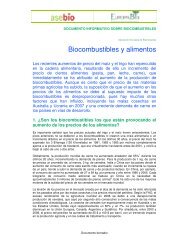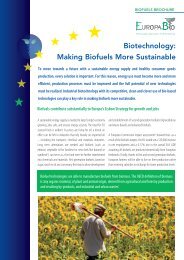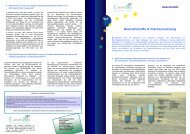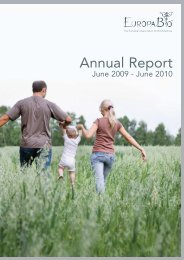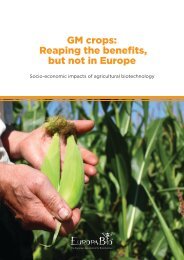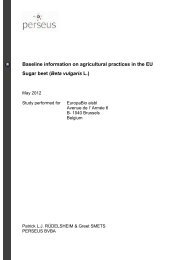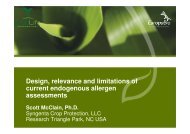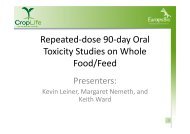our publication about Biosimilar Medicines - Europabio
our publication about Biosimilar Medicines - Europabio
our publication about Biosimilar Medicines - Europabio
You also want an ePaper? Increase the reach of your titles
YUMPU automatically turns print PDFs into web optimized ePapers that Google loves.
EuropaBio<br />
& <strong>Biosimilar</strong><br />
<strong>Medicines</strong>
E U R O P A B I O A N D B I O S I M I L A R M E D I C I N E S<br />
Contents<br />
• Welcome letter from the Secretary General<br />
of EuropaBio<br />
• Healthcare biotechnology and biosimilars<br />
• Glossary of key terms<br />
• References<br />
• Further information<br />
Healthcare biotechnology and biosimilars<br />
I - The Science<br />
1. Healthcare biotechnology – introduction<br />
2. Why do biological medicines differ from chemical medicines?<br />
3. How are biological medicines manufactured?<br />
4. Intellectual property for biotech medicines<br />
II - <strong>Biosimilar</strong> <strong>Medicines</strong> – Current Issues<br />
1. Naming<br />
2. Health Economics & Pricing<br />
3. Immunogenicity<br />
4. Interchangeability<br />
5. Substitution<br />
III – The Regulation of <strong>Biosimilar</strong>s<br />
1. In Europe<br />
2. Outside of Europe<br />
IV - The market for biosimilars<br />
1. Which biosimilars are currently available in Europe?<br />
2. When are the next biosimilars coming on to the market?<br />
3. What does the market entry of biosimilars mean for the original innovator products?<br />
V - The impact of biosimilars<br />
1. What do patients need to know?<br />
2. What do healthcare professionals need to know?<br />
3. What do payers need to know?
Welcome letter by EuropaBio<br />
E U R O P A B I O A N D B I O S I M I L A R M E D I C I N E S<br />
Biotechnology has enabled the discovery of<br />
treatments for some of the most serious diseases<br />
known to man – worldwide, the lives of over 325<br />
million people have been transformed by the<br />
availability of a growing number of biotechnology<br />
medicines. Today patients have access to more<br />
than 155 biotechnology drugs and vaccines, and<br />
medical science is working to increase that number<br />
every day. There are more than 418 biotechnology<br />
medicines in development, covering more than 100<br />
diseases i . These include 210 medicines for cancer, 50<br />
for infectious diseases, 44 for autoimmune diseases,<br />
and 22 for AIDS/HIV and related conditions.<br />
As the exclusive rights (patents and other data<br />
protection) for certain biological medicines expire,<br />
similar biological medicines or “biosimilars” are<br />
being developed. Some of these are already on<br />
the market in Europe. This document is intended<br />
to explain the complexities of biotech medicines,<br />
including biosimilar medicines, and to give an<br />
insight into what patients, healthcare professionals<br />
and other interested individuals should know<br />
<strong>about</strong> biotech and biosimilar medicines.<br />
Willy DeGreef<br />
Secretary General, <strong>Europabio</strong><br />
03
E U R O P A B I O A N D B I O S I M I L A R M E D I C I N E S<br />
...patients<br />
have access<br />
to more<br />
than 155<br />
biotechnology<br />
medicines and<br />
vaccines...
I - The Science<br />
1. Healthcare biotechnology – introduction<br />
What are biotechnology medicines*<br />
and how do they work?<br />
E U R O P A B I O A N D B I O S I M I L A R M E D I C I N E S<br />
Biotechnology uses biological systems and living<br />
organisms to make or modify products or processes<br />
for specific use ii . Biotechnology medicines are just<br />
one of the many applications of biotechnology in<br />
healthcare. There are several prominent categories<br />
of biotechnological medicines:<br />
• Recombinant proteins can replace insufficient<br />
or malfunctioning proteins in the human body.<br />
One example of a recombinant protein is insulin,<br />
which is commonly used in the treatment of<br />
diabetes. Other recombinant proteins like<br />
antibodies or vaccines are used in the treatment<br />
or prevention of serious diseases such as cancer.<br />
• Nucleic acids like DNA or RNA are used in<br />
gene-therapy treatments to restore or modulate<br />
specific disease-related genes.<br />
• Tissues and cells are used for tissue repair after<br />
severe injuries e.g., skin transplants.<br />
• Inactivated forms of micro-organisms are used as<br />
vaccines to prevent diseases provoked by these<br />
micro-organisms (mostly viruses). Vaccines work<br />
by stimulating an immune response against a<br />
disease-causing micro-organism.<br />
• Complex chemical molecules like antibiotics,<br />
which are used for the treatment of bacterial<br />
infections, can be either directly obtained from<br />
micro-organisms (e.g. penicillin is produced<br />
by a certain type of fungus), or can be further<br />
modified by chemical processes (e.g. half-synthetic<br />
antibiotics like ampicillin).<br />
Furthermore, many biotechnological healthcare<br />
products are used widely for diagnostic purposes.<br />
*For the purpose of this document, we use the term “biotech medicine” or<br />
“biological medicine” or “biopharmaceutical” for recombinant protein products.<br />
05
E U R O P A B I O A N D B I O S I M I L A R M E D I C I N E S<br />
The history of healthcare biotechnology<br />
06<br />
Although the modern healthcare biotechnology<br />
industry is only 30 years old, the science of<br />
biotechnology has been explored since the 19th<br />
century when eminent scientists such as Louis<br />
Pasteur and Robert Koch first developed the<br />
science of microbiology, the forerunner of today’s<br />
biotechnology. In 1953, James Watson and Francis<br />
Crick discovered DNA and in 1955, Fred Sanger<br />
determined the amino acid sequence of insulin.<br />
In 1972, Paul Berg created the first recombinant<br />
DNA molecule. DNA engineering has become the<br />
basis of modern biotechnology as it allows the<br />
re-arrangement (“recombination”) of so far<br />
unrelated genetic sequences and the use of those<br />
molecules for the production of recombinant<br />
proteins for medical purposes.<br />
The first biotech companies were founded in the<br />
1970s and many more in the early 1980s. Most of<br />
today’s healthcare biotech companies began life<br />
as small start-ups established by a handful of<br />
enthusiastic visionary scientists on a shoe-string<br />
budget. The hard work of the early pioneers has<br />
now come to fruition: today, over 325 million<br />
people have had their lives transformed by<br />
healthcare biotechnology treatments and it is<br />
estimated that by 2010, around 50 percent of<br />
new medicines will be of biological origin iii .
2. Why do biological medicines differ from<br />
chemical medicines?<br />
What are the differentiating factors?<br />
E U R O P A B I O A N D B I O S I M I L A R M E D I C I N E S<br />
Biological medicines are far more complex<br />
and usually much bigger in size than chemical<br />
medicines, which are produced by chemical<br />
synthesis. This means that their manufacturing and<br />
precise characterisation tends to be more difficult<br />
than for chemical medicines, the ingredients of<br />
which are more easily identifiable and can be<br />
exactly reproduced.<br />
1. Biological medicines show a higher variability.<br />
As biological medicines are produced by living<br />
systems, such as cell lines, they show a higher<br />
variability than traditional (chemical)<br />
pharmaceuticals. As a consequence, each<br />
biological medicine is unique. This could be<br />
likened to the signature of a person; each time<br />
a person (biological) signs something, their<br />
signature will be slightly different, whereas a<br />
printed (chemical) signature remains exactly<br />
the same.<br />
2. Biological medicines are more complex.<br />
Proteins consist of one or more chains of<br />
potentially several hundred amino acids with a<br />
complex three-dimensional structure. Their<br />
molecular size is, therefore, bigger than that of<br />
chemical medicines. These large molecules are<br />
diverse and difficult to characterize. In contrast,<br />
the molecular structure of chemical medicines<br />
is relatively simple, which can allow them to be<br />
exactly reproduced.<br />
3. Biological medicines have the potential to<br />
provoke immune reactions.<br />
Biological medicines, because of their<br />
composition and large molecular size, have<br />
the ability to stimulate the body to mount an<br />
immune response, i.e. produce antibodies against<br />
a protein that the human body recognizes as<br />
“foreign”. “Small molecule” chemical medicines,<br />
07
E U R O P A B I O A N D B I O S I M I L A R M E D I C I N E S<br />
on the other hand, are too small to be recognized<br />
on their own by the immune system. Chemical<br />
medicines can sometimes provoke rare negative<br />
immune reactions like allergy or hypersensitivity<br />
when they bind to naturally occurring proteins in<br />
the body. However, these reactions are generally<br />
short-lived; once levels of the chemical medicine<br />
have decreased in the body, the negative immune<br />
response will, in most cases, disappear and no<br />
longer harm the patient as long as no further<br />
exposure to the medicine occurs.<br />
The potential to provoke an immune response in<br />
the body (immunogenicity) is a double-edged sword<br />
for all biological medicines. Vaccines specifically<br />
exploit this immunogenic potential by provoking an<br />
immune response that recognizes and “fights off” an<br />
“invader” substance. However, for most medicines<br />
based on recombinant proteins, stimulating an<br />
immune response is regarded as undesirable.<br />
Immune responses are complex reactions of the<br />
body and can differ from patient to patient (due to<br />
genetic factors), as well as from disease to disease<br />
(depending on the immune status of the patient).<br />
The likelihood of an immune response can also<br />
be influenced by characteristics of the biological<br />
product itself, such as its formulation, stability and<br />
manufacturing process. The individual manufacturing<br />
process has influence, for example, on the active<br />
substance and the quality and quantity of impurities.<br />
Most of the immune responses that occur are mild<br />
and do have negative effects on the patient, e.g.<br />
in the majority of cases where transient antibodies<br />
to a therapeutic protein are found in the blood. In<br />
rare cases, however, unwanted immune reactions<br />
can have severe, detrimental effects on the health<br />
of a patient, e.g. when so-called “neutralizing”<br />
antibodies appear and make the therapeutic protein<br />
in the biotech medicine ineffective.<br />
08<br />
With biological medicines that resemble the<br />
patient’s own proteins and are intended to replace<br />
insufficient levels of that substance in the patient,<br />
such neutralizing antibodies can even trigger the<br />
body to fight off what remains of the protein<br />
produced by the patient’s body. This immunogenic<br />
reaction can persist for years after the biological<br />
medicine has stopped being administered to the<br />
patient. This potential to elicit a sustained immune<br />
response to a patient’s own protein and block<br />
important biochemical pathways for long periods<br />
of time makes immunogenicity of biological<br />
medicines a particular safety concern.<br />
4. Biological medicines are often administered<br />
via injections.<br />
When taken orally, the digestive system breaks<br />
down proteins (of which biotech medecines<br />
are composed), into their building blocks called<br />
amino acids. This progess would prevent the<br />
protein from reaching the part of the body it<br />
should treat and exerting its therapeutic<br />
function. Therefore biotech medicines must<br />
generally be administered by injection and<br />
cannot be taken orally in the shape of a pill or<br />
capsule like chemical medicines. Antibiotics,<br />
which are complex structures, but not proteins,<br />
can be taken orally or via injections, depending<br />
on the specific need.<br />
5. Biological medicines need special transport and<br />
storage conditions.<br />
Biological material is generally subject to fast<br />
degradation when handled inappropriately.<br />
Therefore, biological medicines usually need<br />
to be stored in a refrigerator and should be<br />
handled under specific conditions.
E U R O P A B I O A N D B I O S I M I L A R M E D I C I N E S<br />
...biotech<br />
medicines<br />
must generally<br />
be administered<br />
by injection...
E U R O P A B I O A N D B I O S I M I L A R M E D I C I N E S<br />
3. How are biological medicines manufactured? Manufacturing biological medicines is generally<br />
10<br />
more complex than the production of traditional<br />
(chemical) pharmaceuticals. Biological medicines<br />
show a higher batch-to-batch variability than<br />
chemical medicines. There are a number of reasons<br />
for this, including the nature of the starting<br />
material and the very high level of precision<br />
required in the manufacturing process.<br />
The starting material for most biological medicines<br />
is a genetically modified cell line. Each biotech<br />
company uses unique cell lines and develops its<br />
own proprietary (unique) manufacturing processes<br />
to produce biological medicines.<br />
The production of biological medicines involves<br />
processes such as fermentation and purification.<br />
Even very small changes to these manufacturing<br />
processes such as minor variations during production<br />
e.g. temperature variations, can result in significant<br />
changes in the clinical properties of the biological<br />
medicine produced. It is therefore vital to precisely<br />
control the manufacturing processes and the<br />
environment inside a production facility, in order to<br />
obtain consistent results and to guarantee the safety<br />
and efficacy of the end product.<br />
The production of biotechnology medicines<br />
requires a high level of monitoring and quality<br />
testing: typically around 250 in-process tests are<br />
conducted for a biological, compared with around<br />
50 tests for a traditional (chemical) medicine.<br />
The unique starting material and the complex<br />
manufacturing processes mean that it is not<br />
possible to exactly reproduce a biological in the<br />
same way a pharmaceutical (chemical) generic can<br />
be produced.
E U R O P A B I O A N D B I O S I M I L A R M E D I C I N E S<br />
4. Intellectual property for biotech medicines Innovative medicines generally benefit from a<br />
certain period of intellectual property protection<br />
via patents and other exclusive rights such as data<br />
protection and market exclusivity. Patent rights<br />
give the patent holder (often, but not always, the<br />
manufacturer), the right to prevent others from<br />
manufacturing, selling, using and importing a<br />
product, or using a process or selling a product<br />
made by that process during a limited period of<br />
time, e.g. 20 years from the date of application.<br />
Data and market exclusivity mean that there is a<br />
period of time after approval before a competitor<br />
can enter the market with a follow-on product that<br />
relies wholly or partly on the originator’s data on<br />
safety and efficacy for its regulatory approval. The<br />
follow-on product can often use an abbreviated<br />
regulatory approval procedure.<br />
Such forms of intellectual property protection<br />
are important for companies that develop and<br />
manufacture new medicines, as it enables them to<br />
recoup their investments and further invest in the<br />
research and development of new medicines.<br />
Follow-on versions of chemical medicines that enter<br />
the market after expiry of IP protection are<br />
called “generics”. Follow-on versions of biological<br />
medicines are called “similar biological medicinal<br />
products” or “biosimilars”. In both cases, the<br />
originator product is called the “reference product”.<br />
Due to certain special features that characterise a<br />
biological medicine, the European Union decided<br />
that the name of follow-on biological medicines<br />
(“biosimilars”) and their regulatory approval pathway<br />
had to be different from chemical “generics”.<br />
11
E U R O P A B I O A N D B I O S I M I L A R M E D I C I N E S<br />
II - <strong>Biosimilar</strong> medicines - current issues<br />
1. Naming<br />
12<br />
All medicines have an International Non-proprietary<br />
Name (INN) and most have a brand name, too.<br />
Chemical pharmaceuticals have the same INN as<br />
the originator product as they are exact copies of<br />
the originator. Due to the complexity of biological<br />
medicinal products, EuropaBio advocates a<br />
revision of the INN nomenclature system so that<br />
each biotechnology-derived medicine is assigned<br />
a distinct INN. Another alternative would be to<br />
ensure that biologicals are always commercialised<br />
with a brand name or the INN plus the<br />
manufacturer’s name.<br />
In some countries, physicians are obliged or<br />
enc<strong>our</strong>aged to prescribe by INN. In such situations<br />
if two biologicals have the same INN, this could<br />
result in products being considered identical<br />
and thus “switched”, when there might be no<br />
scientific evidence to support that switch. Such a<br />
switch could have negative clinical consequences<br />
for the patient, as typically the two products<br />
are similar but not identical, and the differences<br />
between them may have a therapeutic impact.<br />
The European Commission’s proposal for improving<br />
the EU pharmacovigilance iv system stresses the<br />
importance of being able to precisely trace a<br />
biological product. Specifically, the Commission<br />
suggests that marketing authorisation holders<br />
should advise those completing adverse event<br />
reports to provide “the (invented) name and the<br />
batch number”. Also, in order to improve the<br />
pharmacovigilance of biological products including<br />
biosimilars, the Commission has proposed that<br />
Member States ensure that biological medicinal<br />
products that are the subject of adverse reaction<br />
reports be identifiable i.e. traceable. v<br />
2. Health Economics and Pricing<br />
<strong>Biosimilar</strong>s are unlikely to result in the same<br />
price competition as has occurred with the<br />
introduction of generic medicines for a number<br />
of reasons. Firstly, biological medicines including<br />
biosimilars are generally more complex and<br />
costly to produce, e.g. unlike generic medicines,<br />
biosimilars require independent clinical trials to<br />
be undertaken.<br />
Furthermore, the pre-approval regulatory<br />
requirements and post-marketing surveillance<br />
for biosimilars are more rigorous than for<br />
generic medicines, thus adding a further layer to<br />
the cost of producing a biosimilar.<br />
The exact price level of a biosimilar will depend<br />
on the pricing and reimbursement environment<br />
of each country, the competitiveness of the<br />
market and the desire to enc<strong>our</strong>age the future<br />
development of new products.<br />
3. Immunogenicity –<br />
what is it and why does it matter?<br />
Biologicals have the inherent potential to<br />
provoke (unwanted) immune reactions (see<br />
chapter I part 2 above). This potential is one of<br />
the major reasons why biologicals are generally<br />
treated differently to chemical medicines by<br />
regulatory authorities.<br />
While a lot is known today <strong>about</strong> certain<br />
features of biological products that make them<br />
more likely to provoke immune reactions e.g.<br />
high content of host cell proteins and certain<br />
routes of administration, it is currently not<br />
possible to accurately predict immunogenicity in<br />
humans only through non-clinical assessment in
animals. Therefore, immunogenicity assessment<br />
through clinical studies plays a major role in the<br />
development of biological medicines.<br />
At the time a biosimilar receives market approval, a<br />
lot is already known <strong>about</strong> the safety and efficacy of<br />
the product class and the reference product, which<br />
at this point has usually been on the market for<br />
years (or even decades). However, the potential to<br />
provoke immune reactions can differ from product<br />
to product and rare effects can only be detected and<br />
assessed when large numbers of patients have been<br />
treated with a product. At the time of approval,<br />
information on the safety of a medicinal product<br />
is relatively limited for several reasons, such as a<br />
limited number of patients in clinical trials, a limited<br />
time of exposure to the medication and, generally, a<br />
rather strictly defined patient population.<br />
Unlike chemical generics, biosimilars need to have a<br />
“Risk Management Plan” in place. This acknowledges<br />
the special characteristics of biologicals. As with<br />
other new medicines, this Risk Management Plan<br />
defines a set of “pharmacovigilance activities and<br />
interventions designed to identify, characterise,<br />
prevent or minimise risks relating to medicinal<br />
products, and the assessment of the effectiveness of<br />
these interventions”. vi<br />
The potential of biologicals to provoke immune<br />
reactions has been the major reason for treating<br />
biosimilars in the same way as new (biological)<br />
products with regard to post-marketing surveillance.<br />
4. Interchangeability<br />
Interchangeability of medicinal products refers to<br />
the situation where one product is “switched” for<br />
another equivalent product in a clinical setting,<br />
without a risk of an adverse health outcome.<br />
E U R O P A B I O A N D B I O S I M I L A R M E D I C I N E S<br />
Generic medicines, which are considered<br />
bioequivalent, are regarded as “therapeutically<br />
equivalent and therefore, interchangeable” vii .<br />
The current state of scientific knowledge means<br />
that, in general, (chemical) generic medicines<br />
can be deemed interchangeable with their<br />
reference product. Regulatory agencies such as<br />
the European <strong>Medicines</strong> Agency (EMEA) do not<br />
assess the interchangeability or substitutability of<br />
a biosimilar when granting a positive opinion for<br />
a marketing authorisation application. In other<br />
words, the granting of approval does not mean<br />
that the biosimilar product can be interchanged or<br />
substituted with the reference product.<br />
Currently, no clinical studies have been designed<br />
or undertaken to assess the clinical outcome<br />
of repeated switches (changes) of a biological<br />
medicine, whether using two original biological<br />
medicines or an original and a biosimilar.<br />
5. Substitution<br />
Automatic substitution (or generic substitution) is<br />
where the pharmacist substitutes a brand name<br />
(chemical) medicine for a generic version of the<br />
same drug. Some countries make generic substitution<br />
mandatory under certain conditions, for example<br />
where the doctor prescribes by INN. Generic<br />
substitution is often linked to reimbursement; for<br />
example, some health insurance schemes will only<br />
reimburse the patient for the cost of the generic<br />
version of a product. The result of this is that a<br />
patient refusing the generic version and insisting on<br />
the original product must pay the difference in cost.<br />
Generic versions of chemical pharmaceuticals which<br />
have demonstrated their bioequivalence may be<br />
substituted with no risk to patient safety.<br />
13
E U R O P A B I O A N D B I O S I M I L A R M E D I C I N E S<br />
The EMEA has specifically stated that “since<br />
biosimilars and biological reference products are<br />
not identical, the decision to treat a patient with a<br />
reference product or biosimilar medicine should be<br />
taken following the opinion of a qualified health<br />
professional”*. In addition, there is currently no<br />
convincing scientific data to prove that repeated<br />
product switching of biological medicines<br />
(whether biosimilar versions or not) does not<br />
lead to negative clinical consequences. Moreover,<br />
regulators need to remain prudent in matters<br />
relating to the protection of public health.<br />
A number of countries such as France, Italy, Spain,<br />
UK, Netherlands, Germany, Sweden, have either<br />
established legislative measures to prohibit the<br />
automatic substitution of biotech medicines or<br />
have given regulatory advice on the use of biologics<br />
(including prescription by brand). The justification<br />
for such measures is that of patient safety.<br />
EuropaBio firmly believes that other countries that<br />
allow automatic substitution of generic medicines<br />
should take the necessary measures to prevent<br />
automatic substitution of biologics.<br />
*http://www.emea.europa.eu/pdfs/human/pcwp/7456206en.pdf<br />
14
III - The Regulation of <strong>Biosimilar</strong>s<br />
1. In Europe<br />
Chemical medicines can be approved by the national<br />
medicines authorities of individual EU member states.<br />
In contrast, biological products, including biosimilars,<br />
have to follow the “centralized procedure” for<br />
approval carried out by the European <strong>Medicines</strong><br />
Agency (EMEA). Applications submitted to the EMEA<br />
are assessed by its Committee for Human Medicinal<br />
Products (CHMP), which can give a positive or negative<br />
opinion. Upon receipt of a positive opinion from the<br />
EMEA, the European Commission issues a marketing<br />
authorisation which is valid for all EU countries.<br />
Since 2003, the European Union has created<br />
a legal and regulatory pathway to enable the<br />
development and marketing of biosimilar<br />
medicines. Directives 2003/63/EC viii and 2004/27/<br />
EC ix , created a legislative route and the EMEA has<br />
subsequently developed a number of regulatory<br />
guidelines concerning the required data needed for<br />
approval of a biosimilar. Besides the “overarching”,<br />
general guideline on biosimilars, the EMEA has<br />
developed guidelines on quality, on non-clinical<br />
and clinical issues, and product-specific annexes<br />
to those on e.g., insulin, epoetin, somatropin and<br />
granulocyte-stimulating growth factor. At the time<br />
of <strong>publication</strong> of this document, further guidelines<br />
were close to being finalised, including guidelines<br />
on interferon-alfa and low-molecular heparin x .<br />
EMEA’s “overarching” guideline on biosimilars xi<br />
specifically states that biosimilar products are<br />
“by definition” not generics, and that the<br />
generic approach to approval “is scientifically not<br />
appropriate” for biosimilars.<br />
In its document “Questions and Answers on<br />
biosimilar medicines”, the EMEA defines biosimilars<br />
as follows xii :<br />
E U R O P A B I O A N D B I O S I M I L A R M E D I C I N E S<br />
“A biosimilar medicine is a medicine which is<br />
similar to a biological medicine that has already<br />
been authorized (the ‘biological reference<br />
medicine’). The active substance of a biosimilar<br />
medicine is similar to the one of the biological<br />
reference medicine. <strong>Biosimilar</strong> and biological<br />
reference medicines are used in general at<br />
the same dose to treat the same disease. Since<br />
biosimilar and biological reference medicines<br />
are similar but not identical, the decision to<br />
treat a patient with a reference or a biosimilar<br />
medicine should be taken following the<br />
opinion of a qualified healthcare professional.<br />
The name, appearance and packaging of a<br />
biosimilar medicine differ to those of the<br />
biological reference medicine.”<br />
The EMEA Q&A document further states that<br />
the “legislation defines the studies that need<br />
to be carried out to show that the biosimilar<br />
medicine is similar and as safe and effective as the<br />
biological reference medicine”. To this end, the<br />
biosimilar approval pathway requires a biosimilar<br />
manufacturer to demonstrate similarity with the<br />
reference product for quality, safety and efficacy.<br />
Specifically, the biosimilar must demonstrate,<br />
through clinical studies, that it has no significant<br />
clinical differences with the reference product.<br />
<strong>Biosimilar</strong> manufacturers must provide all of<br />
the pre-clinical and clinical data required to<br />
demonstrate the similarity of their product with<br />
the reference product, without the need to repeat<br />
unnecessary tests and trials.<br />
The EMEA assesses the level of data required for a<br />
biosimilar marketing authorisation application on a<br />
case-by-case basis, but the level of data required is<br />
still less than for an original biological.<br />
15
E U R O P A B I O A N D B I O S I M I L A R M E D I C I N E S<br />
A biosimilar manufacturer must undertake<br />
pre-clinical and clinical studies in order to submit<br />
relevant data that establishes the quality, safety and<br />
efficacy of the product, as well as its similarity with the<br />
reference product. The biosimilar must demonstrate<br />
the similarity of its active substance in molecular<br />
and biological terms, to the active substance in<br />
the reference product. In addition, the biosimilar’s<br />
similarity with the reference product should extend<br />
to the pharmaceutical form, strength and route<br />
of administration. The data required can include<br />
pre-clinical data from in-vitro and in-vivo (animal)<br />
testing and data generated by clinical trials in healthy<br />
individuals and the target patient population.<br />
When the reference product has more than one<br />
therapeutic indication, i.e. treats more than one<br />
disease,“the efficacy and safety of the biosimilar<br />
medicine may also have to be assessed using<br />
specific tests or studies for each disease”. xiii<br />
Under certain circumstances, the EMEA allows<br />
extrapolation of indication, i.e. a biosimilar that<br />
has demonstrated comparable safety and efficacy<br />
in the “most sensitive” indication can be assumed<br />
to be able to extrapolate that safety and efficacy<br />
to other indications of the reference product.<br />
However, this extrapolation is only allowed if the<br />
indications share the same mode of action and if<br />
it is “appropriately justified by current scientific<br />
knowledge” xiv , without conducting specific clinical<br />
studies for each of those indications.<br />
As with all biopharmaceuticals, the EMEA requires<br />
biosimilar manufacturers to prepare a risk<br />
management programme (RMP), which comprises<br />
a safety specification, a pharmacovigilance plan,<br />
an evaluation of the need for risk minimisation<br />
activities and (if deemed necessary), a plan for risk<br />
minimisation activities. The pre-clinical and clinical<br />
testing required as part of the abridged biosimilar<br />
16<br />
approval procedure may not reveal all possible<br />
immunogenicity.<br />
This means that preparing a marketing<br />
authorisation application for a biosimilar is more<br />
costly and complex than for a generic medicine.<br />
Generic manufacturers do not usually have to carry<br />
out non-clinical (i.e., animal) studies or clinical<br />
trials when requesting authorisation. Instead, they<br />
need only demonstrate the bioequivalence of their<br />
product with the reference product. For (chemical)<br />
generic pharmaceuticals, this is normally done by<br />
showing that the blood levels of the two products<br />
are the same when given to a small number of<br />
healthy volunteers.<br />
2. Outside of Europe<br />
At the time of <strong>publication</strong>, the European Union<br />
is the only region that has established a specific<br />
approval pathway for biosimilar medicines. The<br />
US congress is still in the process of developing<br />
legislation that would lead to an approval pathway.<br />
The World Health Organisation and numerous<br />
countries around the world such as Argentina,<br />
Canada, Malaysia, Turkey and Saudi Arabia have<br />
produced draft guidelines on biosimilar medicines.<br />
Regulators in Japan and Korea, amongst other<br />
countries, are currently examining the issue of<br />
biosimiliars.
IV - The Market for <strong>Biosimilar</strong>s<br />
1. Which biosimilars are currently available in Europe?<br />
E U R O P A B I O A N D B I O S I M I L A R M E D I C I N E S<br />
The following table shows the biosimilar medicines that have been approved by the EMEA xv :<br />
TRADE NAME INN SPONSOR REFERENCE<br />
PRODUCT<br />
DECISION DATE<br />
Omnitrope ® somatropin Sandoz Genotropin Approve 12/04/2006<br />
Valtropin ® somatropin BioPartners Humatrope Approve 24/04/2006<br />
Alpheon ® Interferon alfa-2a BioPartners Roferon-A Reject 28/06/2006<br />
Abseamed ®1 epoetin alfa Medice Eprex Approve 28/082007<br />
Binocrit ®1 epoetin alfa Sandoz Eprex Approve 28/08/2007<br />
epoetin alfa Hexal ®1 epoetin alfa Hexal Eprex Approve 28/08/2007<br />
Retacrit ®2 epoetin alfa Hospira Eprex Approve 18/12/2007<br />
Silapo ®2 epoetin alfa STADA Eprex Approve 18/12/2007<br />
Insulin Rapid Marvel ® , Long Marvel<br />
30/70 Mix Marvel ®<br />
Insulin Marvel Humulin Withdraw 16/01/2008<br />
Ratiograstim ® Filgrastim Ratiopharm Neupogen Approve 16/09/2008<br />
Biograstim ® Filgrastim CT Arzneimittel Neupogen Approve 16/09/2008<br />
Tevagrastim ® Filgrastim Teva Neupogen Approve 16/09/2008<br />
Zarzio ® Filgrastim Sandoz Neupogen Positive opinion 20/11/2008 (MA<br />
expected 01/2009)<br />
Filgrastim Hexal4 ® Filgrastim Hexal Neupogen Positive opinion 20/11/2008 (MA<br />
2. When are the next biosimilars coming onto<br />
the market?<br />
The EMEA’s Committee for Human Medicinal<br />
Products (CHMP) is currently assessing several<br />
applications for biosimilars and it is expected that<br />
these products will be approved during the c<strong>our</strong>se<br />
of 2008. The CHMP gave a positive opinion on<br />
three biosimilar versions of filgrastim (reference<br />
product: Amgen’s Neupogen) in February 2008<br />
and a revised opinion in July 2008. These three<br />
biosimilars then received a marketing authorisation<br />
from the European Commission in September 2008.<br />
expected 01/2009)<br />
3. What does the market entry of biosimilars mean<br />
for the original innovator products?<br />
<strong>Biosimilar</strong> products will compete with originator<br />
biologicals, many of which already compete with<br />
other originator products made by different biotech<br />
companies. However, in many cases, biosimilars<br />
are copies of older biological medicines, for which<br />
second-generation biological medicines are already<br />
available. This means that the biosimilar products will<br />
mainly compete with the older biological medicines,<br />
rather than with the most recent treatments<br />
developed by originator companies, which can offer<br />
increased therapeutic benefit to patients.<br />
1 The EMEA approved three licenses for the same EPO made by Sandoz, with two additional licenses being granted to marketing partners Hexal and Medice Arzneimittel.<br />
2 The EMEA approved two licenses for the same EPO made by Hosp /STADA<br />
3 The EMEA approved three licenses for the same Filgrastim made by Ratiopharm/Teva/CT Artzneimittel<br />
4 The EMEA approved two licenses for the same Filgrastim made by Sandoz/Hexal
E U R O P A B I O A N D B I O S I M I L A R M E D I C I N E S<br />
...physicians<br />
must be<br />
allowed<br />
to exercise<br />
appropriate<br />
clinical<br />
judgement...
V - The Impact of <strong>Biosimilar</strong>s<br />
E U R O P A B I O A N D B I O S I M I L A R M E D I C I N E S<br />
1. What do patients need to know? Patients need and deserve to be fully informed<br />
<strong>about</strong> any medical treatment they are receiving.<br />
If a physician chooses to prescribe a medicine<br />
to a patient, the patient should be involved in<br />
that decision, understand why that choice has<br />
been made, and what it will mean for his or her<br />
treatment.<br />
Patients may not be completely aware of the<br />
complexities of biologicals, including biosimilars,<br />
and the implications of using them. These<br />
implications include the potential of different<br />
products provoking different immunogenic<br />
reactions in individual patients. It is important<br />
that patients are not obliged to “switch” their<br />
treatment from an originator to a biosimilar purely<br />
on cost grounds, but that the specific therapeutic<br />
needs of the patient are always taken into account.<br />
According to a survey by the International Alliance<br />
of Patients’ Organizations (IAPO), the key concerns<br />
of patients with regard to biosimilars are xvi :<br />
• Cost and the potential to increase access to<br />
biological treatments<br />
• Safety and efficacy<br />
• Patient information and decision-making<br />
• Regulatory process<br />
• Interchangeability<br />
For these reasons it is very important that the label<br />
and other product information relating to the<br />
biosimilar reflect the specific characteristics (clinical<br />
data, reference product, switching advice etc) of<br />
the biosimilar in question.<br />
19
E U R O P A B I O A N D B I O S I M I L A R M E D I C I N E S<br />
2. What do healthcare professionals need to know? Healthcare professionals need to understand the<br />
20<br />
EMEA approval process for biosimilars, in particular<br />
the abridged clinical data requirements, which can<br />
allow the extrapolation of indication for biosimilars<br />
in certain circumstances.<br />
Furthermore, in relation to interchangeability and<br />
substitution, healthcare professionals should be<br />
aware that the two different products may provoke<br />
different immune reactions in different patients.<br />
Physicians should not feel obliged to prescribe a<br />
certain medication purely on the grounds of cost,<br />
but should be allowed to exercise appropriate<br />
clinical judgement.<br />
For these reasons it is very important that the label<br />
and other product information of the biosimilar<br />
reflect the specific characteristics (clinical data,<br />
reference product, switching advice, etc.) of the<br />
biosimilar in question.
E U R O P A B I O A N D B I O S I M I L A R M E D I C I N E S<br />
3. What do payers need to know? Payers, such as national health systems and health<br />
insurance funds, may be interested in cost-saving<br />
potential. Biological medicines tend to be more<br />
expensive than traditional pharmaceuticals for<br />
a number of reasons. These reasons include the<br />
high costs involved in researching, developing,<br />
producing and marketing biological medicines.<br />
It is important for payers to understand the<br />
cost structure of biological medicines, including<br />
biosimilars, with regard to complex manufacturing<br />
procedures and regulatory requirements, which can<br />
require enhanced post-marketing surveillance.<br />
Evidence so far shows that biosimilars will not<br />
result in the same cost savings that generic<br />
medicines have brought. Due to the fact that<br />
biosimilars have been on the market for a relatively<br />
short period of time, it is not possible to accurately<br />
estimate the average price discount compared to<br />
the originator products. In Germany, the biosimilars<br />
that have been launched so far are available at a<br />
price that is around 25% lower than the originator.<br />
However, it is also true that some biosimilars have<br />
the same price as the originator product.<br />
In addition, it is important that payers understand<br />
that, due to the need to remain prudent in matters<br />
of patient safety, automatic substitution for<br />
biologics should not occur and the choice to use<br />
any biological product should remain in the hands<br />
of the treating physician. The physician must be<br />
allowed to exercise appropriate clinical judgement<br />
to select the best available treatment for the<br />
individual patient. Treatment choice should not be<br />
mandated purely for reasons of cost.<br />
21
E U R O P A B I O A N D B I O S I M I L A R M E D I C I N E S<br />
Glossary of key terms<br />
Adverse event: The occurrence of an undesirable,<br />
unpleasant or life-threatening reaction to a<br />
medicinal product.<br />
Allergy: A disorder of the immune system that<br />
causes reactions such as itching, swollen or<br />
inflamed skin or eyes, runny nose. More extreme<br />
allergic reactions such as anaphylactic shock, which<br />
can be life threatening.<br />
Amino acid: One of several molecules that join<br />
together to form proteins. There are 20 common<br />
amino acids found in proteins.<br />
Antibody (pl: antibodies): Antibodies (also known as<br />
immunoglobulins, abbreviated to Ig) are proteins that<br />
are found in blood or other bodily fluids. Antibodies<br />
are used by the immune system to identify and<br />
neutralize foreign objects, such as bacteria and viruses.<br />
Biological/biotech medicine: A substance made from<br />
a living organism or its products. Biologicals/biotech<br />
medicines may be used to prevent, diagnose, treat<br />
or relieve the symptoms of a disease. For example,<br />
antibodies, interleukins, and vaccines are biologicals.<br />
<strong>Biosimilar</strong>: A similar but not identical version of an<br />
existing biological made following patent expiry by<br />
a different manufacturer than the producer of the<br />
original product.<br />
Biotechnology: Any technological application<br />
that uses biological systems, living organisms, or<br />
derivatives thereof, to make or modify products or<br />
processes for specific use.<br />
DNA: Deoxyribonucleic acid (DNA) is a nucleic acid<br />
that contains the genetic instructions used in the<br />
development and functioning of all known living<br />
organisms and some viruses.<br />
22<br />
Generic (medicine): A copy of an existing (chemical)<br />
medicine, which is bioequivalent to the original<br />
medicine, but is made by a different firm.<br />
Gene therapy: The practice inserting of genes into<br />
an individual’s cells and tissues in order to treat a<br />
disease or correct a generic deficiency.<br />
Genetics: The science of heredity and variation in<br />
living organisms.<br />
Hypersensitivity: The occurrence of undesirable<br />
(damaging, discomfort-producing and sometimes<br />
fatal) reactions produced by the immune system.<br />
Immune system: The collection of mechanisms<br />
within the body that protect against disease by<br />
identifying and killing pathogens and tum<strong>our</strong> cells.<br />
Immunogenic: The potential to cause immune<br />
reactions.<br />
Indication: A valid reason to use a certain test,<br />
medication, procedure, or surgery, which is often<br />
subject to official (regulatory) approval.<br />
Insulin: A hormone that affects metabolism and<br />
causes the body’s cells to take up glucose (sugar)<br />
from the blood and store it as glycogen in the liver<br />
and muscles.<br />
INN: International non-proprietary name.<br />
In-vitro: In the laboratory (outside the body).<br />
In-vivo: In the body (the opposite of in-vitro).
Marketing authorisation: The permission granted<br />
by a regulatory authority to a company to market<br />
a medicinal product following the company’s<br />
submission of required documentation and data<br />
relating to testing and clinical trials of the product.<br />
Medical biotechnology: The production of safe<br />
and effective versions of biological substances<br />
that occur naturally in the human body, in a<br />
scientifically controlled environment in order to<br />
make medicinal products.<br />
Microbiology: The science of studying micro<br />
organisms or microscopic organisms.<br />
Micro-organism: An organism that is so small it<br />
cannot be seen by the human eye.<br />
Molecule: The smallest particle of a substance that<br />
has all of the physical and chemical properties of<br />
that substance. Molecules are made up of one or<br />
more atoms. If they contain more than one atom,<br />
the atoms can be the same (an oxygen molecule<br />
has two oxygen atoms) or different (a water<br />
molecule has two hydrogen atoms and one oxygen<br />
atom). Biological molecules, such as proteins and<br />
DNA, can be made up of many thousands of atoms.<br />
Molecular: Of a molecule<br />
Nucleic acid: A macromolecule composed of chains<br />
of monomeric nucleotides. In biochemistry these<br />
molecules carry genetic information or form<br />
structures within cells.<br />
Patent: A patent is a set of exclusive rights granted<br />
by a state to an inventor or his assignee for a fixed<br />
period of time in exchange for a disclosure of an<br />
invention.<br />
E U R O P A B I O A N D B I O S I M I L A R M E D I C I N E S<br />
Pharmacovigilance: Safety control procedures<br />
which medicines are subject to both before, during<br />
and after their approval by regulatory authorities.<br />
Protein: Large organic compounds made of<br />
amino acids arranged in a linear chain and joined<br />
together by peptide bonds between the carboxyl<br />
and amino groups of adjacent amino acid residues.<br />
Recombinant: In genetics, recombinant means<br />
DNA, proteins, cells, or organisms that are made<br />
by combining genetic material from two different<br />
s<strong>our</strong>ces. Recombinant substances are made in the<br />
laboratory and are being studied in the treatment<br />
of cancer and for many other uses.<br />
Reference product: The original product on which a<br />
biosimilar or generic drug bases its application for<br />
marketing approval.<br />
RNA: Ribonucleic acid is a nucleic acid which is<br />
central to the synthesis of proteins.<br />
Vaccine: A biological preparation which is used<br />
to establish or improve immunity to a particular<br />
disease.<br />
23
Further information<br />
• EMEA working group on biosimilars:<br />
http://www.emea.europa.eu/htms/general/contacts/CHMP/CHMP_BMWP.html<br />
• EMEA guidelines on biosimilar medicines:<br />
http://www.emea.europa.eu/pdfs/human/biosimilar/043704en.pdf (overarching guideline on biosimilars)<br />
http://www.emea.europa.eu/pdfs/human/biosimilar/17073408en.pdf (Erythropoietin products)<br />
• IAPO view on biosimilars:<br />
http://www.patientsorganizations.org/showarticle.pl?id=767<br />
• Wikipedia entry on biosimilars:<br />
http://en.wikipedia.org/wiki/<strong>Biosimilar</strong>s<br />
References<br />
i PhRMA Report, 14 August 2006<br />
ii Adapted from Convention on Biological Diversity (1992)<br />
iii Add PhRMA reference.<br />
iv European Commission proposals to revise EudraLex Volume 9A. For more details please see:<br />
http://ec.europa.eu/enterprise/pharmaceuticals/pharmacos/docs/doc2008/2008_03/pc_vol9_03-2008.pdf<br />
v http://ec.europa.eu/enterprise/pharmaceuticals/pharmacovigilance/docs/public-consultation_12-2007.pdf<br />
vi EMEA “Guideline on Risk Management Systems for Medicinal Products for Human Use”<br />
vii US, Orange Book<br />
viii “In case the originally authorized medicinal product has more than one indication, the efficacy and safety of the medicinal<br />
product claimed to be similar has to be justified or, if necessary, demonstrated separately for each of the claimed indications”<br />
(part II, 4 of Directive 2003/63/EC).<br />
ix “Where a biological medicinal product which is similar to a reference medicinal product does not meet the condition in<br />
the definition of generic medicinal products, owing to, in particular, differences relating to raw materials or differences in<br />
manufacturing processes of the biological medicinal product and the reference biological medicinal product, the results of<br />
appropriate pre-clinical tests or clinical trials relating to these conditions must be provided” (article 10 of Directive 2004/27/EC).<br />
x For guidelines on biosimilars see: http://www.emea.europa.eu/htms/human/humanguidelines/multidiscipline.htm<br />
xi EMEA “Guideline on Similar Biological Medicinal Products” (CHMP/437/04)<br />
xii EMEA’s “Questions and Answers on biosimilars (similar biological medicinal products)”<br />
xiii EMEA’s “Questions and Answers on biosimilars (similar biological medicinal products)”<br />
xiv “Guidance on <strong>Biosimilar</strong> Medicinal Products Containing Erythropoietins”; EMEA/CHMP/94526/2005<br />
xvi See: http://www.patientsorganizations.org/<br />
Avenue de l’Armée 6, B-1040 Brussels - Belgium<br />
Tel : (+32.2) 735.03.13 • Fax : (+32.2) 735.49.60<br />
E-mail : info@europabio.org • www.europabio.org


